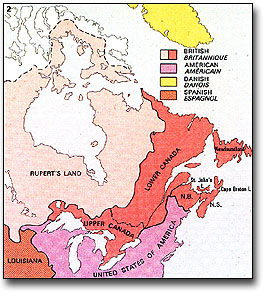
LESSON TITLE: Society in British North America
How does life as a British/French/Indigenous North American in 1763-1800 compare to your life now as a current contributing member of Canadian society?
TIME: 80 minutes
EXPECTATIONS:
Overall:
- A1. Application: Analyze aspects of the lives of various groups in Canada between 1713-1800, and compare them to the lives of people in present day Canada (Focus On: Continuity & Change; Historical Perspective)
Specific:
- A1.1 Analyze key similarities and differences in social values and life between present day Canadians and some different groups and/or communities in Canada between 1713-1800
- A1.2 Analyze some of the main challenges facing individuals and groups in Canada between 1713-1800 and ways in which people responded to those challenges, and assess similarities and differences between some of these challenges and responses and those of present-day Canadians
- A2.6 Communicate the results of their inquiries using appropriate vocabulary and formats appropriate for specific audiences
- A3.3 Identify key social and economic changes that occurred in and/or affected Canada during this period, and explain the impact of some of these changes on various individuals, groups, and/or communities
- A3.4 Describe some significant aspects of daily life among different groups living in Canada during this period and explain their contribution to Canadian heritage or identity
ASSESSMENT:
- Time Capsule Artifact (group assessment)
- Success criteria will be co-created with students on expected practices for group work.
- Historian Blog Entry (individual assessment)
- Students will respond to the following inquiry questions: How does the object that you brought to Show and Tell today represent your current lifestyle? What do you think your artifact will tell people 1000 years from now what society was like during your lifetime?
- Student Self-Assessment (assessment tools)
- Time Capsule Artifact
- I have contributed in some way to my group’s Time Capsule artifact.
1 2 3 4 5
Not at all Somewhat Very much so
- Entries are historically relevant, creative, and highly representative of the daily life of my group’s people.
1 2 3 4 5
Not at all Somewhat Very much so
- Historian Blog Entry
- This blog entry is insightful and answers the question being asked in a clear and articulate way manner.
1 2 3 4 5
Not at all Somewhat Very much so
- This blog entry demonstrates critical thinking and a thorough understanding of the subject area.
1 2 3 4 5
Not at all Somewhat Very much so
PRIOR KNOWLEDGE REQUIRED (of Students):
- In order to successfully participate in this lesson, students should have a clear understanding of the geographies of the different populations, an idea of the different perspectives of various populations, and some knowledge of current Canadian events and present societal norms.
- Students should be familiar with the following vocabulary prior to this lesson: New France, resources, Seven Years War, treaty, Indigenous, Haudenosaunee, British North America, settlers, War of American Independence, Loyalists, Acadians
- New vocabulary presented in this lesson: extortion, small-pox, The Constitutional Act of 1791
- Students should be able to read and analyze primary and secondary documents, be able to research and identify significant information, take notes, and summarize.
ACCOMMODATIONS / MODIFICATIONS:
- Students will be provided with both text and online resources to critically analyze and draw conclusions from for their inquiry, and will be provided with a variety of hands on materials for them to write, sketch, or model artifacts for their group Time Capsules.
- Students will be part of whole group discussions, small group work, and individual work to provide various ways of learning for students.
- ELL students will be given vocabulary sheet prior to the lesson
- All blog reflections may be submitted either orally or in text form
RESOURCES:
The Constitutional Act of the Province of Lower Canada (several pages of original doc): http://eco.canadiana.ca/view/oocihm.21241/2?r=0&s=1
The Nova Scotia Magazine: http://eco.canadiana.ca/view/oocihm.8_06254
Collection of text, maps, documents, & artifacts representing resources & trade: http://www.archives.gov.on.ca/en/explore/online/franco_ontarian/trade.aspx
Canada in the Making: https://web.archive.org/web/20150219015549/http://www.canadiana.ca/citm/themes/aboriginals _e.html
TEACHING / LEARNING TASKS:
MINDS ON: 20 minutes
Whole Class Show & Tell
At the beginning of the lesson, students will be invited to form a Community Sharing Circle (a strategy that they are familiar with) and bring objects from home to the circle. The Talking Stick will be passed around and students holding the rock will be asked to:
- Describe their object, what it is, and where it came from.
- Explain why they chose that object to represent their current lifestyle. Students will be encouraged to share their own understandings of current Canadian society, describing the physical and political environment, touching upon some current events and ongoing issues.
- The critical question: “How does life as a British/French/Indigenous North American in 1763-1800 compare to your life now as a current member of Canadian society?” will be introduced, and the students will split into their pre-set groups to prepare for The Constitutional Act mini-lesson and research period.
ACTION: 50 minutes
Whole Class
- Mini-lesson on The Constitutional Act of 1791 (15 mins)
- Ask students: What do we remember from last class? (Instruct students to take out materials for note-taking)
- Pull up resource on projector: Canada in the Making: https://web.archive.org/web/20150219015549/http://www.cana diana.ca/citm/themes/aboriginals_e.html
- Go through resource together with students, encouraging students to think critically, picking out key points of information that they felt to be most relevant to know about the Constitutional Act of 1791
Group Work
- Research & Time Capsule activity (35 mins)
- Students will get into pre-selected groups
- Each student will be provided a device and encouraged to explore print resources as well
- Each group will be given a series of Inquiry questions having to do with their respective peoples that are to help guide their creation of an artifact to contribute to the class Time Capsule. The questions are listed below and will be provided on a hand-out for each group to reference
- Artifacts may take the form of: miniature models of food/objects/trinkets, “letters”, personal notes, official documents or transcripts, etc.
Inquiry questions from the Ontario curriculum
| The French | The Loyalists | The Haudenosaunee |
| What was life like for the French colonies? What were their spiritual practices? How did they educate their children? What was their system of government? How did they meet their needs for food and clothing? What were their medical practices? How did the roles of men and women differ? | What was life like for the Loyalists? What were their spiritual practices? How did they educate their children? What was their system of government? How did they meet their needs for food and clothing? What were their medical practices? How did the roles of men and women differ? | What was life like for the Haudenosaunee? What were their spiritual practices? How did they educate their children? What was their system of government? How did they meet their needs for food and clothing? What were their medical practices? How did the roles of men and women differ? |
CONSOLIDATION: 10 minutes
Whole Class & Individual
After activity wrap-up, students are invited to rejoin the Community Sharing Circle to share their group’s artifact, and contribute it to the class Time Capsule. Students are encouraged to respond to some or all of the inquiry questions that guided their research and explain briefly how this research helped them in the creation of their artifact.
HOMEWORK:
Blog entry – Respond to the following questions:
- How does the object that you brought to Show and Tell today represent your current lifestyle?
- What do you think your artifact will tell people 1000 years from now what society was like during your lifetime?
